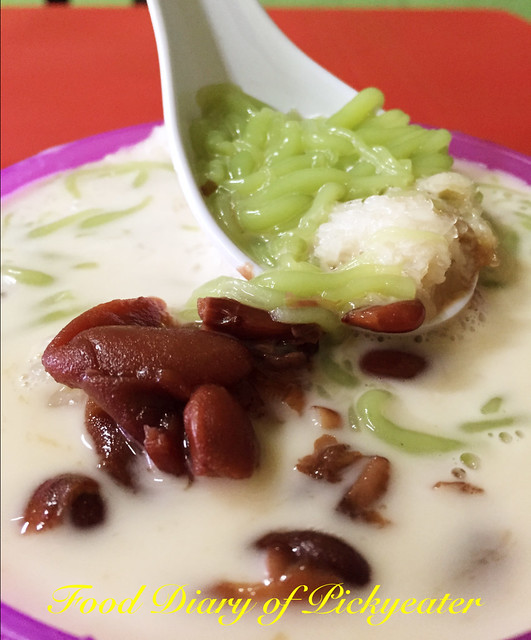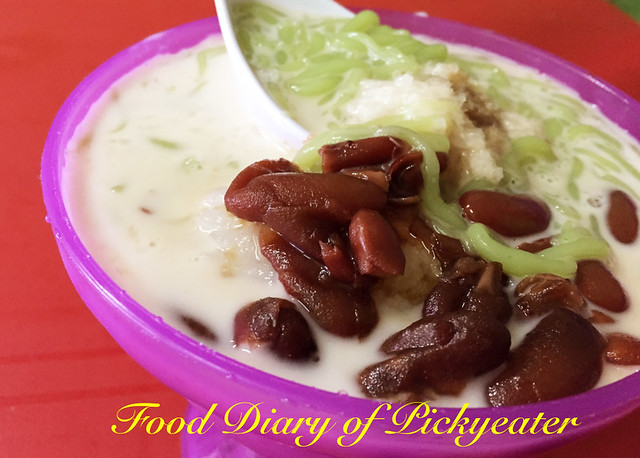
Imagine a bowl of icy cold palm syrup and coconut milk in light brown color tone filled with shaved ice, red beans and green jelly strips, in your hand.
That is the image of the popular traditional dessert; Cendol.
Cendol refers to the short noodle strips flavored and owing its color to the green pandan leaves crushed for its juices found in the dessert, but this main ingredient is often highlighted as the star of the dessert that the name of the dessert itself takes after this green noodle/worm-like jelly substance.
A good bowl of cendol is always welcomed by the locals and can be easily found on the streets.
It is a dessert fare favored by the local folks in the region.
I am not a fan of cendol; never was and still is not.
The wriggly worm-like texture of the rice flour concoction which come
in short-length strips just suppress my mind of thoughts to associate it with
anything edible and it is not hard to figure why.
It is though, personal judgments aside, a popular ingredient found
commonly in desserts especially in the regions of Southeast Asia; such as
Indonesia, Malaysia, Thailand, Cambodia, Vietnam, Singapore, Brunei and
Myanmar.
The term cendol is believed to originate from the term ‘jendol’; of
Indonesian origin, or as widely believed in Indonesia as it strongly resembles
the green-colored worm-like rice flour jelly which appears to be bulging or
swollen in shape.
Interestingly too, the term “jendol” itself is a word for swollen, bulge, or a bump in the local languages of the Indonesian, Javanese and Sundanese.
Interestingly too, the term “jendol” itself is a word for swollen, bulge, or a bump in the local languages of the Indonesian, Javanese and Sundanese.
(Source: Wikipedia)
It is a perfectly logical reference to the cendol we know; in its
ultimate squiggly form as it is made out from the rice flour dough immersed
with that green dye, which obtains its color from the natural pandan juice squeezed from the pandan leaves themselves (or sometimes just the pandan essence).
The pandan leaves itself too could be included in the preparation of this dessert, to lend that pleasantly natural aroma to the bowl of dessert.
The pandan leaves itself too could be included in the preparation of this dessert, to lend that pleasantly natural aroma to the bowl of dessert.
The rice flour dough is pressed through a sieve as it is warm to fall
into its wriggly strips in a container filled with cold water; to maintain the
natural bounce yet firm nature of the strips, as described in the process of
the making of these dessert favorites.
It is not too difficult to make these green wormy strips, as it was made
out to be.
Due to its rice flour origin which is purely the dough paste, the
cendol is bland in taste (rice flour) and is seldom used on its own but rather
as the complement in the desserts where it is usually one of the ingredients.
The cendol is often given its taste with the sweet soup; along with ice and
milk or coconut milk to create that exotic taste familiar to the Asian taste
buds.
The variations of the cendol are almost similar to each other; as it is
served in the different countries and one can simply be prepared to enjoy that
same cendol when one travels to the countries mentioned above where cendol is
almost synonymous to that part of their local delicacies.
In Malaysia, cendol is also associated with the notion of desserts and
can be found in its sweet relishing variations almost everywhere in the region.
From street stalls (most common) to cafes and restaurants, it is not too
difficult to find a version of this in the dessert sections of most menus
though it remains in its popularity as one of the street food.
The cendol in Malaysia has much to owe to the Peranakan origins and is
a popular favorite in the sweet soup of palm sugar (Gula Melaka) further
thickened with the fragrant coconut milk.
Throw in the red beans and shaved ice, and you have got yourself one of
the most popular desserts favored by the local Malaysians.
Cendol is usually served in bowl as described above, or one can also
opt for the drink which is still the same formula as above sans the red bean
(or even with the red beans for those who are fans of the protein-packed
buddies).
The popularity of cendol has been the source of inspiration for the
business owners who have incorporated the very concept of cendol recipes and
serving mouth-watering cendol-themed desserts to the food savvy locals in the
country.
Creativity is always inspiring but in the case of cendol, creativity
could step aside for the convention wins this time where the traditional way of
plain serving cendol with the concoction of palm sugar syrup laden soup mixed
with coconut milk, shaved ice and red beans is just the way to go.
Nothing could top that and there are many stalls found by the roadside
and even in markets selling just that exact version.
To date, the most famous cendol stalls are found in both Penang and
Melaka; the two sister straits states which also share the Peranakan heritage
in their legacy.
Mention Penang Road Cendol which is purportedly a Teochew
styled-version and the Melaka’s Jonker Street Cendol, and you will have many
approving nods with smiles on their faces.
Now, onto the highlight of this post, the discovery of an existing popular gem in the heart of the town of Lunas, Kulim.
Now, onto the highlight of this post, the discovery of an existing popular gem in the heart of the town of Lunas, Kulim.
Best Cendol in Kulim: Cendol Istimewa
Little did we know that there is another gem hidden all the way up north; in the humble dainty town of Kulim, now on the rise with the settlement of industrialization on its land since almost a decade ago.
(Perhaps there are even more hidden gems which we are probably unaware
all around the country; in places less explored).


I was not a fan of cendol to begin with, and therefore this is
definitely an unbiased commentary based on my own experience.
It would be rather hard to even entice me to take just a taste, and I
am just that stubborn skeptic who could just sit there while someone enjoys
mouthfuls of sweet dessert and watch.
Yes, I will not take even a tiny spoonful even if you make me, if I
really do not want to, especially when it comes to food that I have made up my
mind not to like.
I just am that picky.
Cendol is unfortunately on that list, but the very publication of this
post is proof that I have taken that unimaginable step to taste the dessert
this time round, just to justify for the much-acclaimed popularity.
I was not surprised, and it is a move that I did not regret.
I have tried cendol before (a very very long time ago, and perhaps only
once in a blue moon – almost close to never) and most of them are just the
usual with its sweet taste overwhelmed by the palm sugar syrup.
(I am already not a fan of sweet stuffs to begin with, so most of them
did not catch my fancy after just one taste).
(I am sorry that I am such a picky eater, read that blog name).
(I am sorry that I am such a picky eater, read that blog name).
This version; did just the unexpected.
I was pleasantly surprised by the mild sweetness yet enticing flavorful
taste of the palm sugar syrup concoction diluted with the perfect amount of
shaved ice to even the sugary taste and also the light barely-there coconut
milk.
I am not exactly friendly with dairy products and coconut milk is one
ground that I thread on with extreme care due to the rejection and intolerance
issues, but this was quite mild and I really mean light.



Pulut or sticky glutinous rice is used in this version; an addition to
the usual suspects of cendol and red bean and in thick coagulated lumps found
in the dessert. The pulut enhances the flavor of the cendol and lends its
savory taste to even out the congregation of its other companions in the
combination.
Pulut lovers would be delighted to see the generous amount of the
glutinous rice which also helps with that silky smooth taste of the soup and
chunks of the pulut would definitely make a serving filling for even the
adventurous eaters.
The star is however, the Cendol itself; the theme of where the entire
combination is centered upon and rightfully so, for it is called Cendol for a
reason and this particular version nodded to its existence.
The cendol is not forgettable; evident from its delicate and ultra
smooth texture which just seems to slip through the tongue and straight into
the throat as one takes a bite.
Imagine a spoonful of these slinky babies and you won’t even know they
were there; they were just that slippery smooth.
I was amazed by the slick nature of these handmade rice flour strips;
for most could still remind one of its rice flour origins with its taste but
these were just perfect, or almost.
I can’t imagine myself proclaiming my love for these slimy stuffs which
I never even liked in the first place, but I am a convert.
I was told that this is the second branch of the Kulim Cendol; where
they originally run a small stall right outside their house along the Kulim
main road.
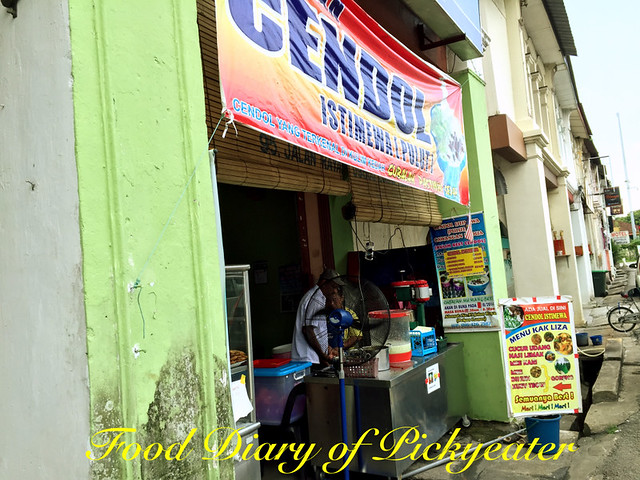

They are open for only two hours daily (previously in the original and first stall); for their cendol sells faster than hot cakes out of the oven.
Their success is attributed to the hordes of cendol fans from the local
population and of course, the industrial folks.
It is not hard to see why and I am glad that they have since expanded
their business to their second outlet; which has just begun its operations
early this year in this shoplot located in the quaint little town of Lunas
which is famous for their duck rice (the duck rice shop is located right
opposite this row of shophouses).

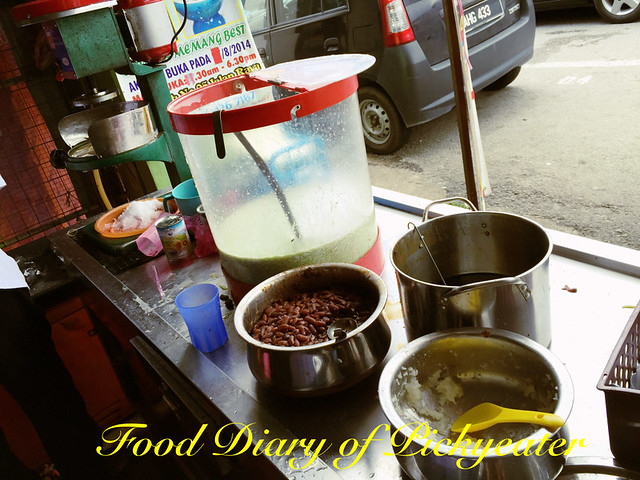
Opening Hours
Now they are open daily, except on Mondays
Operating Hours: Not stated on the time they open (TBD), but they should be there by 12 noon and until 6.30pm
Prices:
Per Bowl: MYR2.00
Takeaway in packet: MYR2.50
Serving in cup with spoon: MYR2.20
They do sell some snacks such as the Cucur Udang (fried prawn fritters) which could go fairly well with the icy cold dessert.
I did not get to try this out, so I can't comment much.


Opening Hours
Now they are open daily, except on Mondays
Operating Hours: Not stated on the time they open (TBD), but they should be there by 12 noon and until 6.30pm
Prices:
Per Bowl: MYR2.00
Takeaway in packet: MYR2.50
Serving in cup with spoon: MYR2.20
They do sell some snacks such as the Cucur Udang (fried prawn fritters) which could go fairly well with the icy cold dessert.
I did not get to try this out, so I can't comment much.
Cendol Istimewa (translated as Special Cendol) is truly worthy of its
name, and I say they deserve every bit the crown of being the Best Cendol in
Kulim; or maybe even in the northern region.

This is truly one special Cendol one has got to try, thumbs-up!
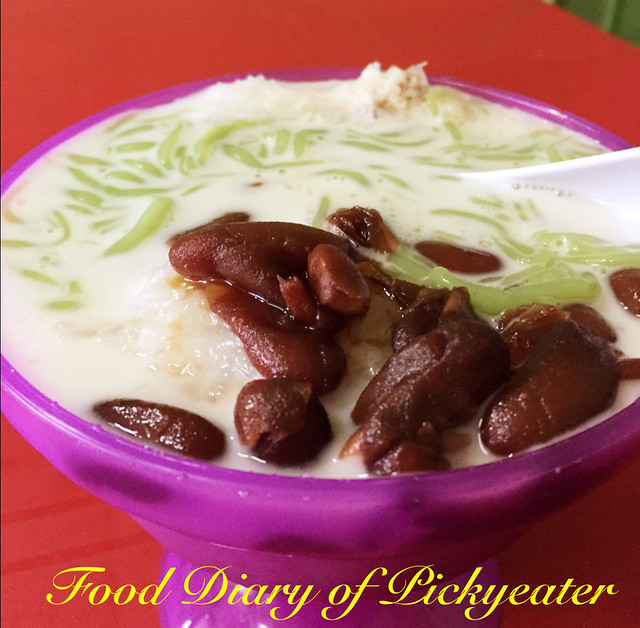
*Take this from a non-Cendol fan*
I think it needs no further justification for the Cendol being declared as a Malaysian heritage food by our very own Malaysian Department of National Heritage.




